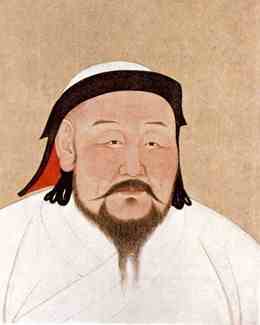A new exhibit featuring massive statues, dragon-shaped roof ridge ornaments and art from the Yuan dynasty gives visitors a glimpse of ancient China that the first Westerners would have seen 700 years ago.
 "The World of Khubilai Khan: Chinese Art in the Yuan Dynasty," at the Metropolitan Museum of Art features 200 works of art. Many are being shown outside of China for the first time.
"The World of Khubilai Khan: Chinese Art in the Yuan Dynasty," at the Metropolitan Museum of Art features 200 works of art. Many are being shown outside of China for the first time.
It focuses on the era spanning the birth in 1215 of Khubilai Khan, Gengis Khan's grandson and the Mongol founder of the Yuan dynasty, to its fall in 1368.
"As you enter the galleries, you'll discover the extraordinary world of Khubilai Khan, in a sense, as Marco Polo did," said Thomas Campbell, the director of the museum.
Khubilai Khan was the emperor who welcomed Marco Polo to China in 1275.
The show, which opens on Tuesday and runs through January 2, is the museum's largest exhibit about Asian art since "China: Dawn of a Golden Age" in 2004.
Two 10-foot (3-meter) tall, 8,000-pound (3,636 kg) statues of Yuan dynasty officials welcome visitors to the exhibit, which includes paintings, sculptures, gold and silver, tapestries, ceramics and religious and secular pieces meant to give visitors a flavor of everyday life.
All of the pieces illustrate a taste in ancient China for fine art, such ceramic containers for transporting wine and elaborate jewelry.
The eclectic styles reflect the unification of China under the Yuan dynasty, which Khubilai Khan founded in 1271, and the influx of artisans from across the Mongol empire. The Yuan dynasty included what is now modern day Mongolia, Tibet and North China.
"This is the culmination of many years of work, and is certainly among the most complex exhibitions ever presented by the museum," Campbell said of the show, which took seven years to organize.
The Metropolitan Museum of Art collaborated with other museums including the Beijing Art Museum of Stone Carvings and the Palace Museum in Beijing, to assemble the exhibit. Many items are from relatively recent archaeological finds in China.
One of the most striking elements of the show is the depiction of the Yuan dynasty as a religious melting pot tolerant of Daoists, Nestorian Christians from Syria, and Indian traders, who were able to build Hindu temples.
The show includes the model of a stage, showing the enthusiasm people had for the performing arts, and the influence of ancient plays on modern Chinese opera.
Author: Phil Wahba | Source: Reuters [September 24, 2010]